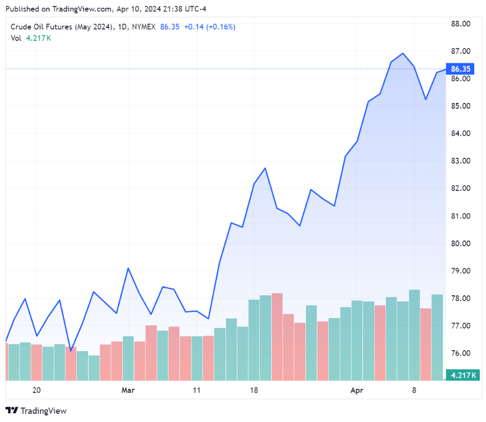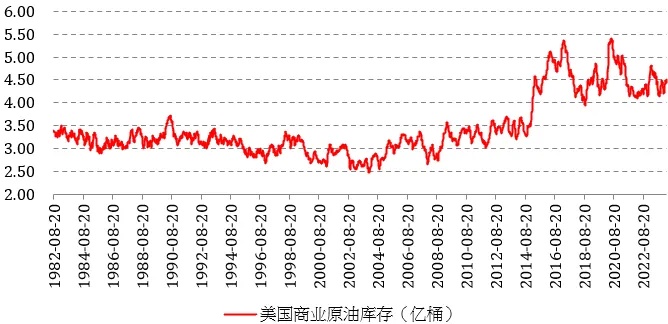Driven by the escalation of geopolitical conflicts, market concerns about the tense situation in the Middle East and the interruption of energy supplies such as oil, international crude oil once soared sharply.
The picture shows the price trend of the May WTI crude oil futures contract, which is currently hovering at $86.35.

From the perspective of supply and demand, the sluggish demand has led to no large-scale destocking even though OPEC continued to cut production. However, U.S. crude oil took the opportunity to seize market share and increased production and exports on a large scale. The global crude oil supply is not tight. The rise in crude oil prices is mainly due to the geopolitical crisis and speculative buying under the expectation of the Fed's interest rate cut.
Looking ahead, we believe that the U.S. economy is unexpectedly strong, coupled with the extension of OPEC's production cuts, the geopolitical crisis has only temporarily eased but not completely ended, and crude oil prices will remain high. Whether it can rush to $100/barrel still needs strong demand.
OPEC production cuts have not led to tight supply
After the epidemic, the dominant force in international crude oil prices mainly comes from the supply side, especially the energy surplus, OPEC and US shale oil production has declined, trying to rebalance the crude oil market, and the geopolitical crisis has brought new challenges to crude oil supply and prices.
Variables, the energy crisis once led to a sharp rise in natural gas and crude oil prices, but insufficient demand made crude oil prices eventually show a trend of rising and falling, and the high price appeared in March 2022. From the perspective of the future crude oil market, supply is still an important variable affecting the crude oil market, but insufficient demand has reduced the boosting effect of production cuts on crude oil prices.
According to OPEC's monthly report, it is estimated that in December 2023, the global crude oil supply will be about 100 million barrels per day, while the global crude oil demand will be about 103 million barrels per day. Since the supply estimated by OPEC is under the premise of implementing OPEC's strict production reduction, in fact, due to the problem of the implementation rate of production reduction, the supply may be underestimated. The actual crude oil supply is about 103 million barrels per day, and the global crude oil supply and demand may be roughly balanced.
In terms of production, according to data released by OPEC, OPEC crude oil production in February was about 26.571 million barrels per day, an increase of 203,000 barrels per day from January and a decrease of 110,000 barrels per day from December last year. It can be seen from this that although OPEC is reducing production, the implementation of production reduction is not good.
In March, OPEC did not further expand production cuts. OPEC produced 26.86 million bpd of crude oil in March, little changed from the previous month, according to a Bloomberg survey. Several OPEC members, including Saudi Arabia and Kuwait, complied with the output cut agreement, but some others did not. Iraq, the United Arab Emirates and Gabon combined are producing hundreds of thousands of barrels a day above agreed quotas.
Russia's crude oil production has been affected to a certain extent by the Ukrainian drone attack. In April, Russia cut production by 350,000 bpd and exports by 121,000 bpd. In May, Russia's production fell by 471,000 barrels per day, in the form of a reduction in production by 400,000 barrels per day and a reduction in exports by 71,000 barrels. However, in the past quarter, Russia's crude oil exports have maintained rapid growth.
From the perspective of inventory, the depletion of global crude oil inventories is relatively slow, which can verify that there is no shortage of global crude oil supply in the first quarter of this year. As of the week of March 29, commercial crude oil inventories in the United States were still as high as 451 million barrels, an increase of about 20 million barrels from the end of last year.
For the whole year, global oil supply in 2023 will increase by about 1.83 million barrels per day year-on-year, of which the United States and South America will contribute 1.02 million barrels per day and 550,000 barrels per day of crude oil output respectively, completely offsetting OPEC Crude oil production decreased by 460,000 barrels per day year-on-year.
The picture shows U.S. commercial crude oil inventories

Demand recovery is slow, and the long-term impact of energy transition cannot be ignored
As the U.S. economy grew better than expected in the first quarter, crude oil demand may be revised upwards. The U.S. Energy Information Administration (EIA) raised its forecast for global oil demand by 480,000 bpd to about 102.91 million bpd.
The EIA's forecast is broadly in line with the International Energy Agency's (IEA) demand forecast of 103.2 million barrels per day, further strengthening the consensus on global oil demand growth.
China's oil demand has entered a stage of low growth due to the energy transition, the development of new energy vehicles, and the trend of decarbonization has begun to erode the consumption of fossil fuels.
From January to February 2024, the cumulative growth rate of China's crude oil imports is only 5.1%, far lower than the 11% in 2023. In April, the refining profits of local refineries in my country continued to decline, and the refining profits of main refineries increased.
However, some main refineries are still in the seasonal maintenance period, and the release of crude oil processing demand is insufficient.
India has great potential for crude oil demand growth among emerging economies, but short-term demand growth is not strong and faces great uncertainty. Currently, India's refining capacity is 5.8 million barrels per day, and it plans to increase it by another 1.1 million barrels per day by 2028. Indian Prime Minister Narendra Modi recently announced a plan to increase domestic refining capacity to 9 million barrels per day by 2030, but achieving this goal will require significant investment.
To sum up, the sharp rise in crude oil prices since February is not due to supply shortages, but safe-haven buying induced by geopolitical crises, especially the rising risk of war between Israel and Iran, which has triggered market concerns about Iran's crude oil output and export concerns.
With Israel withdrawing most of its ground troops from southern Gaza on April 7, the situation eased and crude oil prices retreated. However, there is great uncertainty about whether the Palestinian-Israeli conflict will escalate again in the future. Due to the strong U.S. job market, the Fed's interest rate cut expectations have cooled, and the improvement of short-term economic expectations has boosted oil prices.
However, the suppression of crude oil demand by high interest rates in the medium term will continue. Therefore, it is not easy for crude oil to stand firm at $100/barrel, and consumer demand needs to improve Or match investment needs.
$NQ100 Index Main 2406 (NQmain) $$Dow Jones Main 2406 (YMmain) $}$WTI Crude Oil Main Company 2405 (CLmain) $ $SP500指数主连 2406(ESmain)$ $黄金主连 2406(GCmain)$
Comments